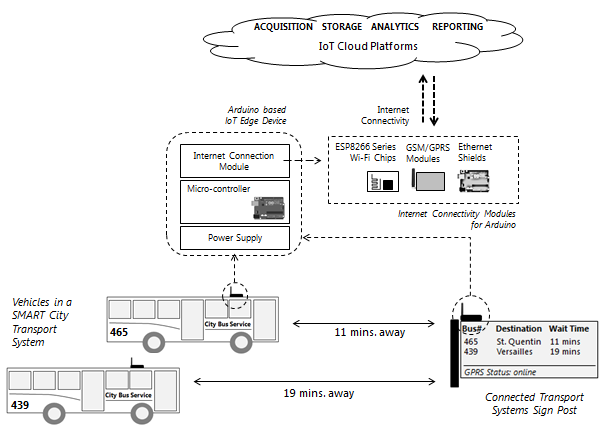The IoT edge devices help in connecting the existing machines to an IoT cloud platform. They are essentially hardware components with embedded software that provide an operating environment for running custom programs for:
- Interfacing with connected machines: The edge device sits in between the existing machines and the IoT cloud. It serves as a bridge over which data is exchanged between the existing machines and the IoT cloud.
- Reading parameters or signals from connected machines: The edge device also has custom code (for example, Arduino sketches) embedded and running inside it. The embedded sketch/programs serve to interface with the machine that is being connected to the internet.
- Connecting to the internet: The embedded programs in the edge devices help to connect easily to the existing internet. For this purpose, various types of connecting media are utilized. Some of the popular methods are wireless GPRS (General Packet Radio Service) or GSM (Global System for Mobile), Wi-Fi Chips, and hard-wired LAN cable shields.
- Transmitting data to an IoT cloud: The edge device also runs embedded software that provides functionality to send data to the IoT cloud platform being used. Often, the IoT cloud platform vendors provide their own device compatible header files, the use of which becomes very easy to establish connectivity and transmit data to the IoT cloud. It is also sometimes possible that the IoT device manufacturers themselves provide IoT cloud compatible header files that can be readily used with our programs/sketches. It depends on a case-to-case basis.
- Fetching data from an IoT cloud: Similarly, the edge device also runs embedded software that provides functionality to read data from IoT cloud platforms.
- Hosting local endpoints for receiving requests from an IoT cloud: This is an advanced technique; hence it is good to know the basic purpose of this technique. Often this technique is employed for edge devices to be invoked directly from the IoT cloud platforms using certain IoT protocols such as the Messaging Queue Telemetry Transport (MQTT) protocol.
- Sending signals and controlling the connected machines: The edge devices are also responsible for sending signals and controlling the physical machine that is being connected to the internet:

In the preceding diagram, a very practical prototype of a smart city transport system has been depicted. The buses plying in the city continuously send data regarding their current location to the IoT cloud platform.
In each bus stop, there is an electronic sign post, which continuously fetches information regarding how far away a bus is and then displays the retrieved information in the information panel. Thus, the preceding IoT application fulfils a very important purpose for the citizens of the smart city.
As depicted earlier, a basic Arduino-based IoT edge device is composed of the following fundamental parts:
- A microprocessor or microcontroller unit (which in the case of our study will be the Arduino) that serves as the brain of the edge device. In actual practice, field grade microprocessor units are used for industrializing the actual edge device product.
- An internet connectivity module for facilitating internet connections. Some popular varieties include the GPRS/GSM module, Wi-Fi chips, and Ethernet shields. For learning the basics, we will use the ESP8266 Wi-Fi module with the Arduino platform.
